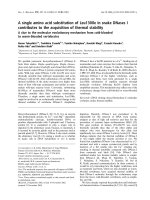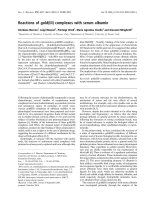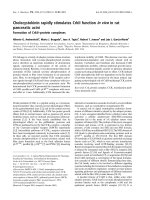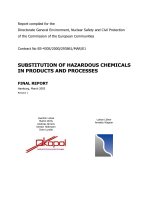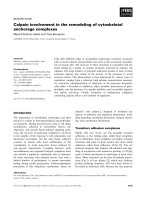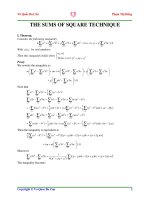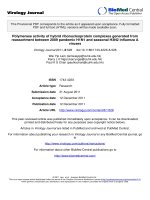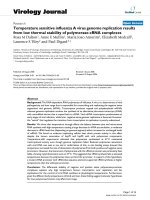Substitution of square planar complexes
Bạn đang xem bản rút gọn của tài liệu. Xem và tải ngay bản đầy đủ của tài liệu tại đây (681.34 KB, 34 trang )
Chapter 12
Coordination Chemistry IV
Reactions and Mechanisms
Coordination Compound Reactions
• Goal is to understand reaction mechanisms
• Primarily substitution reactions, most are rapid
Cu(H2O)62+ + 4 NH3 [Cu(NH3)4(H2O)2]2+ + 4 H2O
but some are slow
[Co(NH3)6]3+ + 6 H3O+ [Co(H2O)6]3+ + 6 NH4+
Coordination Compound Reactions
• Labile compounds - rapid ligand exchange
(reaction half-life of 1 min or less)
• Inert compounds - slower reactions
• Labile/inert labels do not imply stability/instability
(inert compounds can be thermodynamically
unstable) - these are kinetic effects
• In general:
– Inert: octahedral d3, low spin d4 - d6, strong field d8 square planar
– Intermediate: weak field d8
– Labile: d1, d2, high spin d4 - d6, d7, d9, d10
Substitution Mechanisms
• Two extremes:
Dissociative (D, low coordination number
intermediate)
Associative (A, high coordination number
intermediate)
• SN1 or SN2 at the extreme limit
• Interchange - incoming ligand participates in
the reaction, but no detectable intermediate
– Can have associative (Ia) or dissociative (Id)
characteristics
• Reactions typically run under conditions of
excess incoming ligand
• We’ll look briefly at rate laws (details in text),
consider primarily octahedral complexes
Substitution Mechanisms
Substitution Mechanisms
Pictures:
Substitution Mechanisms
Determining mechanisms
What things would you do to determine the
mechanism?
Dissociation (D) Mechanism
• ML5X ML5 + X
ML5 + Y ML5Y
•
k1, k-1
k2
1st step is ligand dissociation. Steady-state hypothesis assumes small [ML 5], intermediate is
consumed as fast as it is formed
d[ML5 Y]
k2 k1[ML5 X][Y]
=
dt
kĞ1[X] + k2 [Y]
• Rate law suggests intermediate must be
observable - no examples known where it can be
detected and measured
• Thus, dissociation mechanisms are rare -
Interchange Mechanism
• ML5X + Y ML5X.Y
ML5X.Y ML5Y + X
k1, k–1
k2
RDS
• 1st reaction is a rapid equilibrium between ligand
and complex to form ion pair or loosely bonded
complex (not a high coordination number). The
second step is slow.
d[ML5 Y]
k2 K1[M]0 [Y]0
k2 K1[M]0 [Y]0
=
≅
dt
1 + K1[Y]0 + (k2 /kĞ1 )
1 + K1[Y]0
Reactions typically run under conditions where [Y] >>
[ML5X]
Interchange Mechanism
• Reactions typically run under conditions where [Y] >>
[ML5X]
[M]0 = [ML5X] + [ML5X.Y] [Y]0 ≅ [Y]
• Both D and I have similar rate laws:
• If [Y] is small, both mechanisms are 2nd order
(rate of D is inversely related to [X])
If [Y] is large, both are 1st order in [M]0, 0-order in
d[ML5 Y]
k2 K1[M]0 [Y]0
k2 K1[M]0 [Y]0
=
≅
[Y]
dt
1 + K1[Y]0 + (k2 /kĞ1 )
d[ML5 Y]
k k [ML5 X][Y]
= 2 1
dt
kĞ1[X] + k2 [Y]
1 + K1[Y]0
Interchange Mechanism
D and I mechanisms have similar rate laws:
Dissociation
ML5X ML5 + X
ML5 + Y ML5Y
Interchange
k1, k-1
k2
ML5X + Y ML5X.Y
ML5X.Y ML5Y + X
k1, k–1
k2 RDS
•If [Y] is small, both mechanisms are 2nd order (and
rate of D mechanism is inversely related to [X])
•If [Y] is large, both are 1st order in [M]0, 0-order in
[Y]
Association (A) Mechanism
ML5X + Y ML5XY
k1, k-1
ML5XY ML5Y + X
k2
•1st reaction results in an increased coordination
number. 2nd reaction is faster
d[ML5 Y]
k1k2 [ML5 X][Y]
=
≅ k[ML5 X][Y]
dt
kĞ1 + k2
•Rate law is always 2nd order, regardless of [Y]
•Very few examples known with detectable
intermediate
Factors affecting rate
• Most octahedral reactions have dissociative
character, square pyramid intermediate
• Oxidation state of the metal: High oxidation
state results in slow ligand exchange
[Na(H2O)6]+ > [Mg(H2O)6]2+ > [Al(H2O)6]3+
• Metal Ionic radius: Small ionic radius results in
slow ligand exchange (for hard metal ions)
[Sr(H2O)6]2+ > [Ca(H2O)6]2+ > [Mg(H2O)6]2+
• For transition metals, Rates decrease down a
group
2+
2+
2+
Dissociation Mechanism
Evidence: Stabilization Energy and rate of H2O exchange
Entering Group Effects
Small incoming ligand effect = D or Id mechanism
Entering Group Effects
Not close = Ia mechanism
Close = Id mechanism
Activation Parameters
RuII vs. RuIII substitution
Conjugate Base Mechanism
onjugate base mechanism: complexes with NH3-like or H2O ligands
ose H+, ligand trans to deprotonated ligand is more likely to be
ost.
[Co(NH3)5X]2+ + OH- ↔ [Co(NH3)4(NH2)X]+ + H2O (equil)
[Co(NH3)4(NH2)X]+ [Co(NH3)4(NH2)]2+ + X- (slow)
[Co(NH3)4(NH2)]2+ + H2O [Co(NH3)5H2O]2+ (fast)
Conjugate Base Mechanism
Conjugate base mechanism: complexes with NR3 or H2O ligands,
lose H+, ligand trans to deprotonated ligand is more likely to be
lost.
Reaction Modeling using
Excel Programming
Square planar reactions
Associative or Ia mechanisms, square pyramid intermediate
Pt2+ is a soft acid. For the substitution reaction
trans-PtL2Cl2 + Y → trans-PtL2ClY + Cl– in CH3OH
ligand will affect reaction rate:
PR3>CN–>SCN–>I–>Br–>N3–>NO2–>py>NH3~Cl–>CH3OH
Leaving group (X) also has effect on rate: hard ligands are
lost easily (NO3–, Cl–) soft ligands with π electron density
are not (CN–, NO2–)
Trans effect
• In square planar Pt(II) compounds, ligands trans
to Cl are more easily replaced than others such
as ammonia
• Cl has a stronger trans effect than ammonia (but
Cl– is a more labile ligand than NH3)
• CN– ~ CO > PH3 > NO2– > I– > Br– > Cl– > NH3 > OH–
> H2O
• Pt(NH3)42+ + 2 Cl– PtCl42– + 2 NH3
• Sigma bonding - if Pt-T is strong, Pt-X is weaker
(ligands share metal d-orbitals in sigma bonds)
• Pi bonding - strong pi-acceptor ligands weaken
P-X bond
• Predictions not exact

